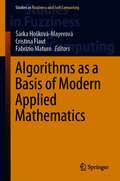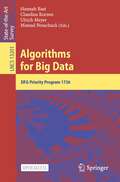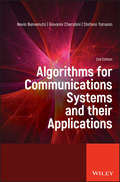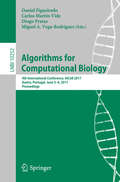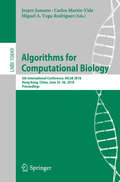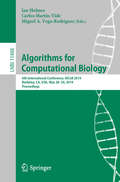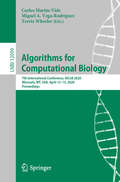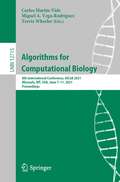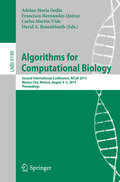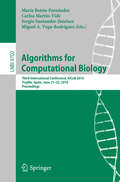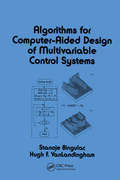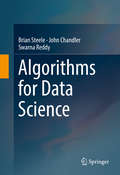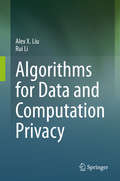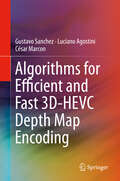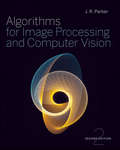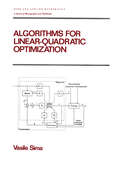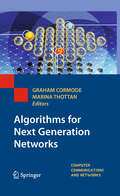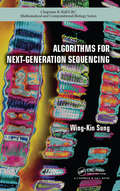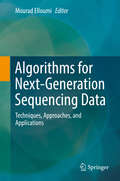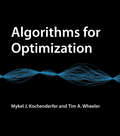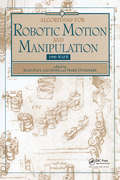- Table View
- List View
Algorithms as a Basis of Modern Applied Mathematics (Studies in Fuzziness and Soft Computing #404)
by Šárka Hošková-Mayerová Fabrizio Maturo Cristina FlautThis book offers a self-contained guide to advanced algorithms and their applications in various fields of science. Gathering contributions by authoritative researchers in the field of mathematics, statistics and computer science, it aims at offering a comprehensive and up-to-date view of algorithms, including the theory behind them, as well as practical considerations, current limitations and solutions. It covers applications in energy management, decision making, computer networks, materials science, mechanics and process optimization. It offers an integrated and timely guide to important algorithms, and represents a valuable reference resource for graduate students and researchers in various fields of applied mathematics, statistics and engineering.
Algorithms for Big Data: DFG Priority Program 1736 (Lecture Notes in Computer Science #13201)
by Ulrich Meyer Hannah Bast Claudius Korzen Manuel PenschuckThis open access book surveys the progress in addressing selected challenges related to the growth of big data in combination with increasingly complicated hardware. It emerged from a research program established by the German Research Foundation (DFG) as priority program SPP 1736 on Algorithmics for Big Data where researchers from theoretical computer science worked together with application experts in order to tackle problems in domains such as networking, genomics research, and information retrieval. Such domains are unthinkable without substantial hardware and software support, and these systems acquire, process, exchange, and store data at an exponential rate. The chapters of this volume summarize the results of projects realized within the program and survey-related work.This is an open access book.
Algorithms for Communications Systems and their Applications
by Nevio Benvenuto Stefano Tomasin Giovanni CherubiniThis welcome second edition to the 2002 original presents the logical arithmetical or computational procedures within communications systems that will ensure the solution to various problems. The authors comprehensively introduce the theoretical elements which are at the basis of the field of algorithms for communications systems. Various applications of these algorithms are then illustrated with a focus on wired and wireless network access technologies. The updated applications will focus on 5G standards, and new material will include MIMO systems (Space-time block coding / Spatial multiplexing / Beamforming and interference management / Channel Estimation /mmWave Model); OFDM and SC-FDMA (Synchronization / Resource allocation (bit and power loading) / Filtered OFDM); Full Duplex Systems (Digital interference cancellation techniques).
Algorithms for Computational Biology: 4th International Conference, AlCoB 2017, Aveiro, Portugal, June 5-6, 2017, Proceedings (Lecture Notes in Computer Science #10252)
by Daniel Figueiredo, Carlos Martín-Vide, Diogo Pratas and Miguel A. Vega-RodríguezThis book constitutes the proceedings of the 4th InternationalConference on Algorithms for Computational Biology, AlCoB 2017, held in Aveiro, Portugal, in June 2017. The 10 full papers presented together with 2 invited papers were carefully reviewed and selected from 24 submissions. They are organized in the following topical sections: Graph Algorithms for Computational Biology; Phylogenetics; and Sequence Analysis and Other Biological Processes.
Algorithms for Computational Biology: 5th International Conference, AlCoB 2018, Hong Kong, China, June 25–26, 2018, Proceedings (Lecture Notes in Computer Science #10849)
by Carlos Martín-Vide Miguel A. Vega-Rodríguez Jesper JanssonThis book constitutes the proceedings of the 5th InternationalConference on Algorithms for Computational Biology, AlCoB 2018, held in Hong Kong, China, in June 2018. The 11 full papers presented together with 1 invited paper were carefully reviewed and selected from 20 submissions. They are organized in the following topical sections: Phylogenetics, Sequence Rearrangement and Analysis, Systems Biology and Other Biological Processes.
Algorithms for Computational Biology: 6th International Conference, AlCoB 2019, Berkeley, CA, USA, May 28–30, 2019, Proceedings (Lecture Notes in Computer Science #11488)
by Carlos Martín-Vide Miguel A. Vega-Rodríguez Ian HolmesThis book constitutes the proceedings of the 6th InternationalConference on Algorithms for Computational Biology, AlCoB 2019, held in Berkeley, CA, USA, in May 2019. The 15 full papers presented together with 1 invited paper were carefully reviewed and selected from 30 submissions. They are organized in the following topical sections: Biological networks and graph algorithms; genome rearrangement, assembly and classification; sequence analysis, phylogenetics and other biological processes.
Algorithms for Computational Biology: 7th International Conference, AlCoB 2020, Missoula, MT, USA, April 13–15, 2020, Proceedings (Lecture Notes in Computer Science #12099)
by Carlos Martín-Vide Miguel A. Vega-Rodríguez Travis WheelerThis book constitutes the proceedings of the 7th International Conference on Algorithms for Computational Biology, AlCoB 2020, was planned to be held in Missoula, MT, USA in April 2020. Due to the corona pandemic the conference was postponed to be held together with AlCoB 2021.The 15 full papers included in this volume were carefully reviewed and selected from 24 submissions. They were organized in topical sections on genomics, phylogenetics, and RNA-Seq and other biological processes.
Algorithms for Computational Biology: 8th International Conference, AlCoB 2021, Missoula, MT, USA, June 7–11, 2021, Proceedings (Lecture Notes in Computer Science #12715)
by Carlos Martín-Vide Miguel A. Vega-Rodríguez Travis WheelerThis book constitutes the proceedings of the 8th International Conference on Algorithms for Computational Biology, AlCoB 2020, was planned to be held in Missoula, MT, USA in June 2021. Due to the Covid-19 pandemic, AlCoB 2020 and AlCoB 2021 were merged and held on these dates together. AlCoB 2020 proceedings were published as LNBI 12099. The 12 full papers included in this volume were carefully reviewed and selected from 22 submissions. They were organized in topical sections on genomics, phylogenetics, and RNA-Seq and other biological processes. The scope of AlCoB includes topics of either theoretical or applied interest, namely: sequence analysis; sequence alignment; sequence assembly; genome rearrangement; regulatory motif finding; phylogeny reconstruction; phylogeny comparison; structure prediction; compressive genomics; proteomics: molecular pathways, interaction networks, mass spectrometry analysis; transcriptomics: splicing variants, isoform inference and quantification, differential analysis; next-generation sequencing: population genomics, metagenomics, metatranscriptomics, epigenomics; genome CD architecture; microbiome analysis; cancer computational biology; and systems biology.
Algorithms for Computational Biology: Second International Conference, AlCoB 2015, Mexico City, Mexico, August 4-5, 2015, Proceedings (Lecture Notes in Computer Science #9199)
by Carlos Martín-Vide Adrian-Horia Dediu Francisco Hernández-Quiroz David A. RosenbluethThis book constitutes the proceedings of the Second International Conference on Algorithms for Computational Biology, AICoB 2015, held in Mexico City, Mexico, in August 2015. The 11 papers presented in this volume were carefully reviewed and selected from 23 submissions. They were organized in topical sections named: genetic processing; molecular recognition/prediction; and phylogenetics.
Algorithms for Computational Biology: Third International Conference, AlCoB 2016, Trujillo, Spain, June 21-22, 2016, Proceedings (Lecture Notes in Computer Science #9702)
by María Botón-Fernández Carlos Martín-Vide Sergio Santander-Jiménez Miguel A. Vega-RodríguezThis book constitutes the proceedings of the Third InternationalConference on Algorithms for Computational Biology, AlCoB 2016, held inTrujillo, Spain, in June 2016.The 13 full papers presented in this volume were carefully reviewed andselected from 23 submissions. They are organized in the following topical sections: biological networks and modelling; biological structure processing; phylogenetics; and sequence analysis and rearrangement. In addition one invited talk is included.
Algorithms for Computer-Aided Design of Multivariable Control Systems (Electrical and Computer Engineering)
by Stanoje Bingulac Hugh F. VanlandinghamThis reference/text discusses the structure and concepts of multivariable control systems, offering a balanced presentation of theory, algorithm development, and methods of implementation.;The book contains a powerful software package - L.A.S (Linear Algebra and Systems) which provides a tool for verifying an analysis technique or control design.;Reviewing the fundamentals of linear algebra and system theory, Algorithms for Computer-Aided Design of Multivariable Control Systems: supplies a solid basis for understanding multivariable systems and their characteristics; highlights the most relevant mathematical developments while keeping proofs and detailed derivations to a minimum; emphasizes the use of computer algorithms; provides special sections of application problems and their solutions to enhance learning; presents a unified theory of linear multi-input, multi-output (MIMO) system models; and introduces new results based on pseudo-controllability and pseudo-observability indices, furnishing algorithms for more accurate internodel conversions.;Illustrated with figures, tables and display equations and containing many previously unpublished results, Algorithms for Computer-Aided Design of Multivariable Control Systems is a reference for electrical and electronics, mechanical and control engineers and systems analysts as well as a text for upper-level undergraduate, graduate and continuing-education courses in multivariable control.
Algorithms for Convex Optimization
by Nisheeth K. VishnoiIn the last few years, Algorithms for Convex Optimization have revolutionized algorithm design, both for discrete and continuous optimization problems. For problems like maximum flow, maximum matching, and submodular function minimization, the fastest algorithms involve essential methods such as gradient descent, mirror descent, interior point methods, and ellipsoid methods. The goal of this self-contained book is to enable researchers and professionals in computer science, data science, and machine learning to gain an in-depth understanding of these algorithms. The text emphasizes how to derive key algorithms for convex optimization from first principles and how to establish precise running time bounds. This modern text explains the success of these algorithms in problems of discrete optimization, as well as how these methods have significantly pushed the state of the art of convex optimization itself.
Algorithms for Data Science
by John Chandler Brian Steele Swarna ReddyThis textbook on practical data analytics unites fundamental principles, algorithms, and data. Algorithms are the keystone of data analytics and the focal point of this textbook. Clear and intuitive explanations of the mathematical and statistical foundations make the algorithms transparent. But practical data analytics requires more than just the foundations. Problems and data are enormously variable and only the most elementary of algorithms can be used without modification. Programming fluency and experience with real and challenging data is indispensable and so the reader is immersed in Python and R and real data analysis. By the end of the book, the reader will have gained the ability to adapt algorithms to new problems and carry out innovative analyses. This book has three parts: (a) Data Reduction: Begins with the concepts of data reduction, data maps, and information extraction. The second chapter introduces associative statistics, the mathematical foundation of scalable algorithms and distributed computing. Practical aspects of distributed computing is the subject of the Hadoop and MapReduce chapter. (b) Extracting Information from Data: Linear regression and data visualization are the principal topics of Part II. The authors dedicate a chapter to the critical domain of Healthcare Analytics for an extended example of practical data analytics. The algorithms and analytics will be of much interest to practitioners interested in utilizing the large and unwieldly data sets of the Centers for Disease Control and Prevention's Behavioral Risk Factor Surveillance System. (c) Predictive Analytics Two foundational and widely used algorithms, k-nearest neighbors and naive Bayes, are developed in detail. A chapter is dedicated to forecasting. The last chapter focuses on streaming data and uses publicly accessible data streams originating from the Twitter API and the NASDAQ stock market in the tutorials. This book is intended for a one- or two-semester course in data analytics for upper-division undergraduate and graduate students in mathematics, statistics, and computer science. The prerequisites are kept low, and students with one or two courses in probability or statistics, an exposure to vectors and matrices, and a programming course will have no difficulty. The core material of every chapter is accessible to all with these prerequisites. The chapters often expand at the close with innovations of interest to practitioners of data science. Each chapter includes exercises of varying levels of difficulty. The text is eminently suitable for self-study and an exceptional resource for practitioners.
Algorithms for Data and Computation Privacy
by Rui Li Alex X. LiuThis book introduces the state-of-the-art algorithms for data and computation privacy. It mainly focuses on searchable symmetric encryption algorithms and privacy preserving multi-party computation algorithms. This book also introduces algorithms for breaking privacy, and gives intuition on how to design algorithm to counter privacy attacks. Some well-designed differential privacy algorithms are also included in this book. Driven by lower cost, higher reliability, better performance, and faster deployment, data and computing services are increasingly outsourced to clouds. In this computing paradigm, one often has to store privacy sensitive data at parties, that cannot fully trust and perform privacy sensitive computation with parties that again cannot fully trust. For both scenarios, preserving data privacy and computation privacy is extremely important. After the Facebook–Cambridge Analytical data scandal and the implementation of the General Data Protection Regulation by European Union, users are becoming more privacy aware and more concerned with their privacy in this digital world. This book targets database engineers, cloud computing engineers and researchers working in this field. Advanced-level students studying computer science and electrical engineering will also find this book useful as a reference or secondary text.
Algorithms for Decision Making
by Mykel J. Kochenderfer Tim A. Wheeler Kyle H. WrayA broad introduction to algorithms for decision making under uncertainty, introducing the underlying mathematical problem formulations and the algorithms for solving them.Automated decision-making systems or decision-support systems—used in applications that range from aircraft collision avoidance to breast cancer screening—must be designed to account for various sources of uncertainty while carefully balancing multiple objectives. This textbook provides a broad introduction to algorithms for decision making under uncertainty, covering the underlying mathematical problem formulations and the algorithms for solving them. The book first addresses the problem of reasoning about uncertainty and objectives in simple decisions at a single point in time, and then turns to sequential decision problems in stochastic environments where the outcomes of our actions are uncertain. It goes on to address model uncertainty, when we do not start with a known model and must learn how to act through interaction with the environment; state uncertainty, in which we do not know the current state of the environment due to imperfect perceptual information; and decision contexts involving multiple agents. The book focuses primarily on planning and reinforcement learning, although some of the techniques presented draw on elements of supervised learning and optimization. Algorithms are implemented in the Julia programming language. Figures, examples, and exercises convey the intuition behind the various approaches presented.
Algorithms for Efficient and Fast 3D-HEVC Depth Map Encoding
by Luciano Agostini Gustavo Sanchez César MarconThis book describes and analyzes in detail the encoding effort and the encoding tool usage applied to 3D-HEVC depth map coding. Based on the analyzed information, the authors introduce efficient algorithms for accelerating the available encoding tools. The contributions discussed in this book include four algorithms for reducing intra-frame encoding effort and three algorithms for reducing inter-frame encoding effort. The presented results demonstrate several levels of encoding effort reduction with different impacts in the encoding efficiency, surpassing state-of-the-art solutions by more than 50% the encoding effort with only 0.3% encoding efficiency loss.
Algorithms for Image Processing and Computer Vision
by J. R. ParkerA cookbook of algorithms for common image processing applicationsThanks to advances in computer hardware and software, algorithms have been developed that support sophisticated image processing without requiring an extensive background in mathematics. This bestselling book has been fully updated with the newest of these, including 2D vision methods in content-based searches and the use of graphics cards as image processing computational aids. It's an ideal reference for software engineers and developers, advanced programmers, graphics programmers, scientists, and other specialists who require highly specialized image processing.Algorithms now exist for a wide variety of sophisticated image processing applications required by software engineers and developers, advanced programmers, graphics programmers, scientists, and related specialistsThis bestselling book has been completely updated to include the latest algorithms, including 2D vision methods in content-based searches, details on modern classifier methods, and graphics cards used as image processing computational aidsSaves hours of mathematical calculating by using distributed processing and GPU programming, and gives non-mathematicians the shortcuts needed to program relatively sophisticated applications.Algorithms for Image Processing and Computer Vision, 2nd Edition provides the tools to speed development of image processing applications.
Algorithms for Linear-Quadratic Optimization (Chapman And Hall/crc Pure And Applied Mathematics Ser. #200)
by Vasile SimaThis textbook offers theoretical, algorithmic and computational guidelines for solving the most frequently encountered linear-quadratic optimization problems. It provides an overview of recent advances in control and systems theory, numerical line algebra, numerical optimization, scientific computations and software engineering.
Algorithms for Minimization Without Derivatives (Dover Books on Mathematics)
by Richard P. BrentThis outstanding text for graduate students and researchers proposes improvements to existing algorithms, extends their related mathematical theories, and offers details on new algorithms for approximating local and global minima. None of the algorithms requires an evaluation of derivatives; all depend entirely on sequential function evaluation, a highly practical scenario in the frequent event of difficult-to-evaluate derivatives.Topics include the use of successive interpolation for finding simple zeros of a function and its derivatives; an algorithm with guaranteed convergence for finding a minimum of a function of one variation; global minimization given an upper bound on the second derivative; and a new algorithm for minimizing a function of several variables without calculating derivatives. Many numerical examples augment the text, along with a complete analysis of rate of convergence for most algorithms and error bounds that allow for the effect of rounding errors.
Algorithms for Next Generation Networks (Computer Communications and Networks)
by Marina Thottan Graham CormodeData networking now plays a major role in everyday life and new applications continue to appear at a blinding pace. Yet we still do not have a sound foundation for designing, evaluating and managing these networks. This book covers topics at the intersection of algorithms and networking. It builds a complete picture of the current state of research on Next Generation Networks and the challenges for the years ahead. Particular focus is given to evolving research initiatives and the architecture they propose and implications for networking. Topics: Network design and provisioning, hardware issues, layer-3 algorithms and MPLS, BGP and Inter AS routing, packet processing for routing, security and network management, load balancing, oblivious routing and stochastic algorithms, network coding for multicast, overlay routing for P2P networking and content delivery. This timely volume will be of interest to a broad readership from graduate students to researchers looking to survey recent research its open questions.
Algorithms for Next-Generation Sequencing (Chapman & Hall/CRC Computational Biology Series)
by Wing-Kin SungAdvances in sequencing technology have allowed scientists to study the human genome in greater depth and on a larger scale than ever before – as many as hundreds of millions of short reads in the course of a few days. But what are the best ways to deal with this flood of data? Algorithms for Next-Generation Sequencing is an invaluable tool for students and researchers in bioinformatics and computational biology, biologists seeking to process and manage the data generated by next-generation sequencing, and as a textbook or a self-study resource. In addition to offering an in-depth description of the algorithms for processing sequencing data, it also presents useful case studies describing the applications of this technology.
Algorithms for Next-Generation Sequencing Data: Techniques, Approaches, and Applications
by Mourad ElloumiThe 14 contributed chapters in this book survey the most recent developments in high-performance algorithms for NGS data, offering fundamental insights and technical information specifically on indexing, compression and stora≥ error correction; alignment; and assembly. The book will be of value to researchers, practitioners and students engaged with bioinformatics, computer science, mathematics, statistics and life sciences.
Algorithms for Optimization
by Mykel J. Kochenderfer Tim A. WheelerA comprehensive introduction to optimization with a focus on practical algorithms for the design of engineering systems. This book offers a comprehensive introduction to optimization with a focus on practical algorithms. The book approaches optimization from an engineering perspective, where the objective is to design a system that optimizes a set of metrics subject to constraints. Readers will learn about computational approaches for a range of challenges, including searching high-dimensional spaces, handling problems where there are multiple competing objectives, and accommodating uncertainty in the metrics. Figures, examples, and exercises convey the intuition behind the mathematical approaches. The text provides concrete implementations in the Julia programming language. Topics covered include derivatives and their generalization to multiple dimensions; local descent and first- and second-order methods that inform local descent; stochastic methods, which introduce randomness into the optimization process; linear constrained optimization, when both the objective function and the constraints are linear; surrogate models, probabilistic surrogate models, and using probabilistic surrogate models to guide optimization; optimization under uncertainty; uncertainty propagation; expression optimization; and multidisciplinary design optimization. Appendixes offer an introduction to the Julia language, test functions for evaluating algorithm performance, and mathematical concepts used in the derivation and analysis of the optimization methods discussed in the text. The book can be used by advanced undergraduates and graduate students in mathematics, statistics, computer science, any engineering field, (including electrical engineering and aerospace engineering), and operations research, and as a reference for professionals.
Algorithms for Robotic Motion and Manipulation: WAFR 1996
by Mark Overmars Jean-Paul LaumondThis volume deals with core problems in robotics, like motion planning, sensor-based planning, manipulation, and assembly planning. It also discusses the application of robotics algorithms in other domains, such as molecular modeling, computer graphics, and image analysis. Topics Include: - Planning - Sensor Based Motion Planning - Control and Moti
Algorithms for Sample Preparation with Microfluidic Lab-on-Chip
by Krishnendu Chakrabarty Bhargab B. Bhattacharya Sukanta BhattacharjeeRecent microfluidic technologies have brought a complete paradigm shift in automating biochemical processing on a tiny lab-on-chip (a.k.a. biochip) that replaces expensive and bulky instruments traditionally used in implementing bench-top laboratory protocols. Biochips have already made a profound impact on various application domains such as clinical diagnostics, DNA analysis, genetic engineering, and drug discovery, among others. They are capable of precisely manipulating micro-/pico-liter quantities of fluids, and provide integrated support for mixing, storage, transportation, and sensing, on-chip. In almost all bioprotocols, sample preparation plays an important role, which includes dilution and mixing of several fluids satisfying certain volumetric ratios. However, designing algorithms that minimize reactant-cost and sample-preparation time suited for microfluidic chips poses a great challenge from the perspective of protocol mapping, scheduling, and physical design. Algorithms for Sample Preparation with Microfluidic Lab-on-Chip attempts to bridge the widening gap between biologists and engineers by introducing, from the fundamentals, several state-of-the-art computer-aided-design (CAD) algorithms for sample preparation with digital and flow-based microfluidic biochips. Technical topics discussed in the book include: Basics of digital and flow-based microfluidic lab-on-chipComprehensive review of state-of-the-art sample preparation algorithmsSample-preparation algorithms for digital microfluidic lab-on-chipSample-preparation algorithms for flow-based microfluidic lab-on-chip
